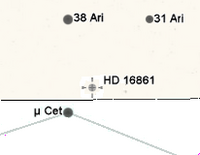 Location 85 Ceti (HD 16861) within the Aries constellation (pink) | |
| Observation data Epoch J2000 Equinox J2000 | |
|---|---|
| Constellation | Aries |
| Right ascension | 02 42 28.93647 |
| Declination | +10° 44′ 30.2137″ |
| Apparent magnitude (V) | 6.30 |
| Characteristics | |
| Spectral type | A2 V |
| U−B color index | +0.06 |
| B−V color index | +0.06 |
| R−I color index | 0.02 |
| Astrometry | |
| Radial velocity (Rv) | +6.1 km/s |
| Proper motion (μ) | RA: –22.88 mas/yr Dec.: –22.95 mas/yr |
| Parallax (π) | 7.87 ± 1.05 mas |
| Distance | approx. 410 ly (approx. 130 pc) |
| Details | |
| Mass | 2.38 ± 0.15 M☉ |
| Luminosity | 48 L☉ |
| Temperature | 8,810 K |
| Rotational velocity (v sin i) | 18 km/s |
| Other designations | |
| BD+10° 360, HD 16861, HIP 12647, HR 797, NSV 899, SAO 93067. | |
| Database references | |
| SIMBAD | data |
85 Ceti is an older Flamsteed designation for a star that is now within the borders of the northern constellation of Aries, the ram. In the present day it is known by star catalogue designations such as HD 16861 and HR 797. It has an apparent visual magnitude of 6.30 and is approximately 410 light-years (130 parsecs) distant from the Earth. This is an A-type main sequence star with a stellar classification of A2 V. It has 2.4 times the mass of the Sun and shines with 48 times the Sun's luminosity. This energy is being radiated into outer space from the star's outer atmosphere at an effective temperature of 8,810 K. This heat gives it the white-hued glow of an A-type star.
References
- ^ van Leeuwen, F. (November 2007), "Validation of the new Hipparcos reduction", Astronomy and Astrophysics, 474 (2): 653–664, arXiv:0708.1752, Bibcode:2007A&A...474..653V, doi:10.1051/0004-6361:20078357, S2CID 18759600.
- ^ Johnson, H. L.; et al. (1966). "UBVRIJKL photometry of the bright stars". Communications of the Lunar and Planetary Laboratory. 4 (99): 99. Bibcode:1966CoLPL...4...99J.
- ^ Cowley, A.; et al. (April 1969), "A study of the bright A stars. I. A catalogue of spectral classifications", Astronomical Journal, 74: 375–406, Bibcode:1969AJ.....74..375C, doi:10.1086/110819.
- Wilson, R. E. (1953), "General Catalogue of Stellar Radial Velocities", Washington, Carnegie Institute of Washington D.C., Bibcode:1953GCRV..C......0W.
- ^ Zorec, J.; Royer, F. (January 2012), "Rotational velocities of A-type stars. IV. Evolution of rotational velocities", Astronomy & Astrophysics, 537: A120, arXiv:1201.2052, Bibcode:2012A&A...537A.120Z, doi:10.1051/0004-6361/201117691, S2CID 55586789.
- Royer, F.; Zorec, J.; Gómez, A. E. (February 2007), "Rotational velocities of A-type stars. III. Velocity distributions", Astronomy and Astrophysics, 463 (2): 671–682, arXiv:astro-ph/0610785, Bibcode:2007A&A...463..671R, doi:10.1051/0004-6361:20065224, S2CID 18475298.
- ^ "HD 16861". SIMBAD. Centre de données astronomiques de Strasbourg. Retrieved 2012-07-18.
- Smart, W. M. (June 1939), "The Ursa Major cluster, (Second paper)", Monthly Notices of the Royal Astronomical Society, 99 (9): 710–722, Bibcode:1939MNRAS..99..710S, doi:10.1093/mnras/99.9.710. Page 712 of this reference links 85 Cet to B.S. 797; B.S., an abbreviation of the Bright Star Catalogue, was an earlier version of the Harvard Revised Photometry Catalogue, or HR. Hence, 85 Ceti is the same as HR 797.
- Hoffleit, D. (July 1979), "Discordances in Star Designations", Bulletin d'Information du Centre de Données Stellaires, 17 (17): 38, Bibcode:1979BICDS..17...38H.
- "The Colour of Stars", Australia Telescope, Outreach and Education, Commonwealth Scientific and Industrial Research Organisation, December 21, 2004, archived from the original on March 18, 2012, retrieved 2012-01-16.
External links
| Constellation of Aries | |||||||||||||
|---|---|---|---|---|---|---|---|---|---|---|---|---|---|
| Stars |
| ||||||||||||
| |||||||||||||
| Galaxies |
| ||||||||||||
| |||||||||||||
| |||||||||||||